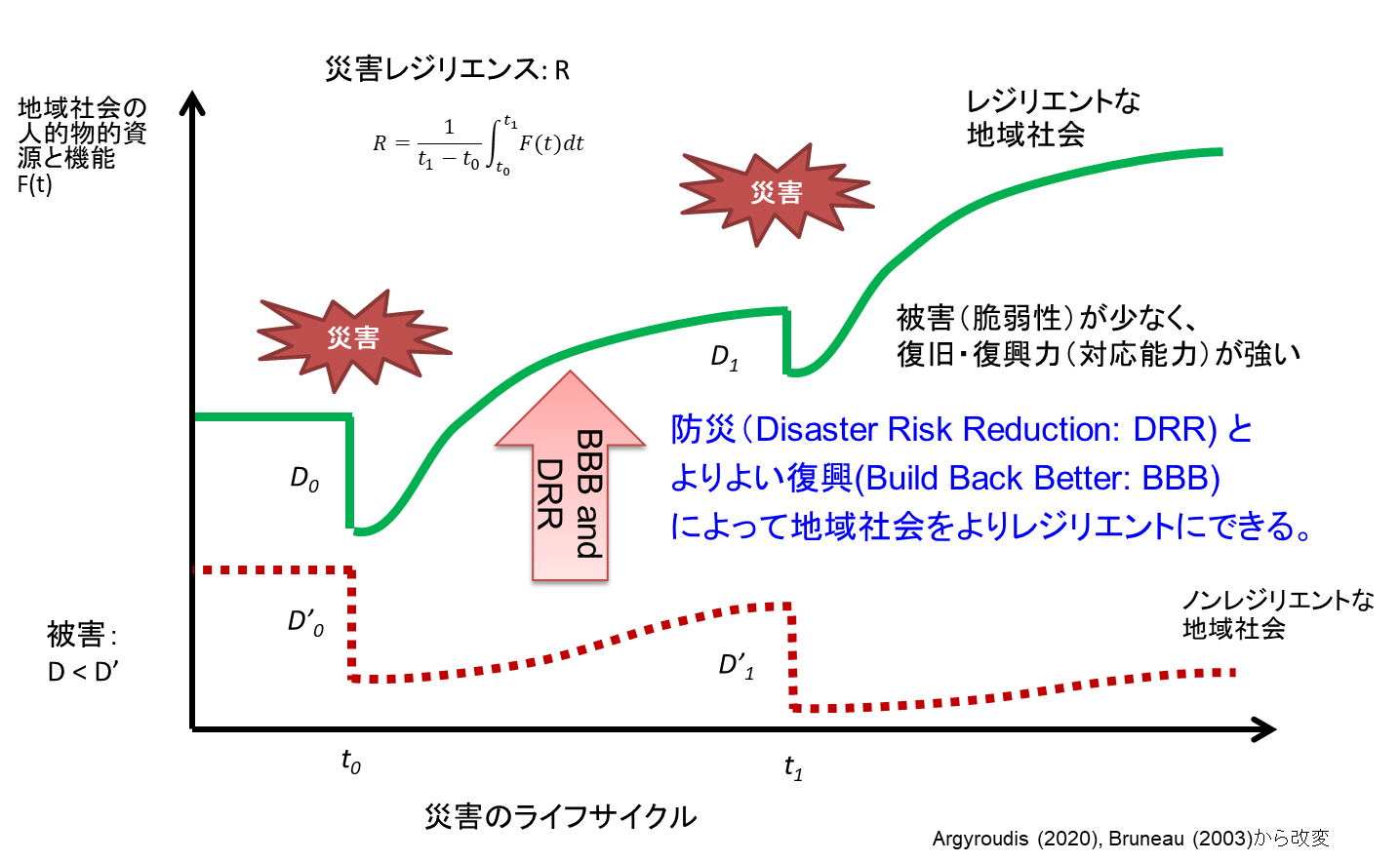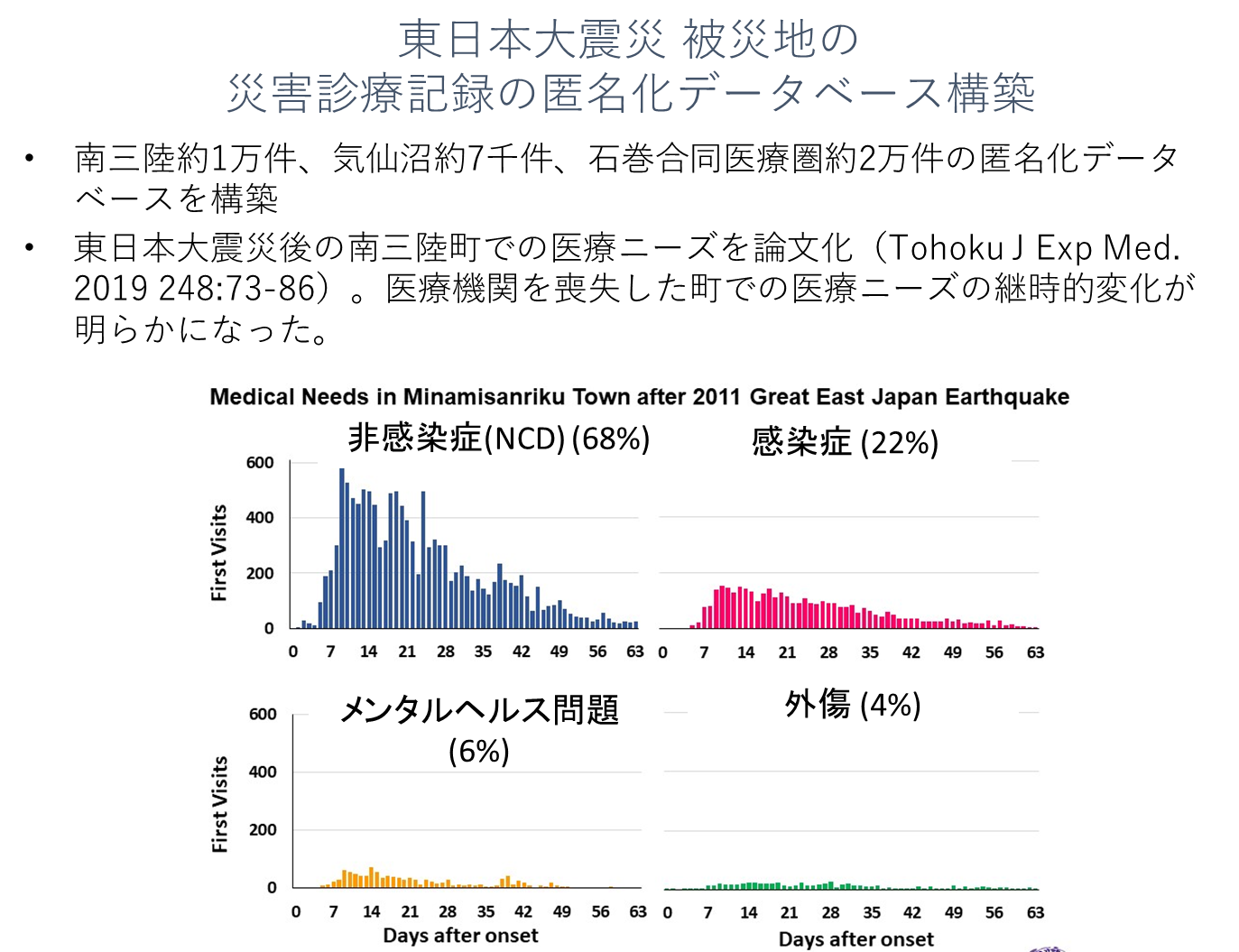医科学専攻 公衆衛生学専攻
International Cooperation for Disaster Medicine(International Research Institute of Disaster Science災害医療国際協力学(災害科学国際研究所)
STAFF
Professor
-
Egawa, ShinichiProfessor.M.D. Ph.D. 江川 新一 教授
Other Faculty / Staff
-
Sasaki, Hiroyuki
Assoc. Prof.M.D. Ph.D. 佐々木 宏之 准教授 -
Park, Hyejeong
Assistant. Prof.R.N. Ph.D. 朴 慧晶 助教
CONTACT
TEL:+81-22-752-2058
E-MAIL:shinichi.egawa.a8*tohoku.ac.jp
(「*」を「@」に変換してください)
OUTLINE
Our Lab aims to improve medical, public health, and welfare providers to sustain a disaster-resilient society. Medical response to disaster was systematically implemented in Japan after the 1995 Great Hanshin-Awaji Earthquake and is a world-leading system. The medical needs after the 2011 Great East Japan Earthquake, however, had a different spectrum. In 2015, the 3rd World Conference for Disaster Risk Reduction was held in Sendai, which adopted the Sendai Framework for Disaster Risk Reduction 2015-2030. The Sendai Framework incorporated the change of health risks in existing and future disasters caused by all types of hazards. Disaster risk is a function of hazard & exposure, vulnerability, and coping capacity, suggesting we can reduce the disaster risk by modulating these factors. Japan has a high life expectancy and low overall disaster risk due to the cyclic improvement of disaster risk reduction and building back better. Our Lab investigates the disaster medical system, business continuity of health facilities, and changes in medical needs during disasters. It conducts simulations using cutting-edge digital-twin technology to assess social and human resilience against disasters. Suggestions and comments are welcome!
私たちの研究室では、災害に対してレジリエントな社会を維持するために医学・公衆衛生・福祉がどのように進化し、貢献できるかを研究しています。わが国の災害医療体制は1995年の阪神淡路大震災を契機に整備され、世界でも最先端を行く体制です。しかし、2011年の東日本大震災でそれまでと異なる医療ニーズが多く発生しました。2015年に仙台で開催された第3回国連世界防災会議では仙台防災枠組2015-2030が採択されました。仙台枠組みは、すべてのハザードによる災害における健康被害のリスクを減少させることが盛り込まれています。災害リスクはハザードと曝露、脆弱性、対応能力の関数として表すことができ、これらの因子を変化させることによってリスクを減らすことができます。わが国は、長寿でかつ、全体の災害リスクが低い状態を達成しており、これは、防災(災害リスク減少)とBuilding Back Better(よりよい復興)によって成し遂げられています。私たちの研究室では、災害医療体制のあり方、保健医療施設の業務継続計画、災害時の医療ニーズ解析、最先端のデジタルツイン技術を用いたシミュレーションなどを通して社会と人間の災害レジリエンスを研究しています。ご質問やご意見を歓迎いたします!

The disaster risk negatively correlates with the life expectancy
平均寿命と災害リスクの逆相関の要因
The concept of disaster resilience
災害レジリエンスの考え方
Medical needs after the 2011 Great East Japan Earthquake
東日本大震災後の医療ニーズ解析
ARTICLE
1. Tsuboi, M., et al. Medical perspective on the systemic challenges involving indirect disaster-related deaths in Japan. Sci Rep. 15(1):5225. 2025
URL:https://doi.org/10.1038/s41598-025-89349-7
2. Chubachi N, et al. Status and Challenges of Convergence Knowledge in Disaster Science: A Qualitative Analysis of Researchers’ Responses at Tohoku University. J Disaster Res. 19(6):943-955. 2024.
URL:https://doi.org/10.20965/jdr.2024.p0943
3. Park H, et al. The Gaps Between Institutional and Practical Disaster Risk Management Measures on Coastal Flood Risks in South Korea’s Coastal Communities. Int J Disaster Risk Sci. 15:594–607, 2024.
URL:https://doi.org/10.1007/s13753-024-00579-1
4. Egawa, S, et al. The 2024 Noto Peninsula Earthquake and the Strategy of Medical Assistance from the Tohoku University Hospital. Tohoku J Exp Med, 262(1):45-49, 2024.
URL:https://doi.org/10.1620/tjem.2024.J010
5.Egawa, S, Experimental Medicine. Tohoku J Exp Med. 262(1):1-3, 2024.
URL:https://doi.org/10.1620/tjem.2023.J096
